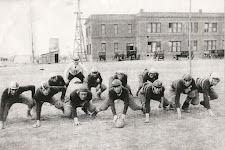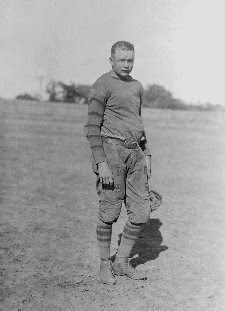 |
| Lack of wind produces vertical smoke. Light west wind nudges smoke to right. |
According to legend, an east or northeast wind meant a "very good” year, north or northwest "average," west or southwest "poor," and south or southeast "very bad.”
The almost forgotten ceremony was revived in Roscoe in the early 1970s by George Parks after learning about it from “Injun John,” who performed it in Muleshoe every year—just as his father had since the 1880s. “Injun George” executed the ritual faithfully in Roscoe for years before going to the happy hunting grounds in 1983. Then in 2012 it was once again revived, this time by “Injun Robert,” i.e., Robert McBride, who has performed it annually since then.
Here’s his record so far with the annual number of bales ginned at the Central Rolling Plains Co-op used as his measure of success.
Year Wind Prediction Bales Ginned
2012 Northwest Average 66,985
2013 Southwest Poor 71,849
2014 Southwest Poor 32,274
2015 Northwest Average 75,636
2016 Southwest Poor 87,827
2017 Southwest Poor 111,598
2018 Southwest Poor 23,372
Last year’s prediction of a poor crop was right on target as the gin produced only 23,372 bales, well below its 12-year average of 63,024.
As with “Injun George” before him, his predictions have been mostly but not always correct. Of the last seven years four were accurate: 2012, 2014, 2015, and 2018, while the other three underestimated the actual yield: 2013, 2016, and 2017. In the latter group, the prediction for a poor crop was from a southwest wind in each case.
However, this year something unusual happened. As usual, “Injun Robert” prepared his fire right before sunrise and, as dawn broke, he checked the smoke’s direction, but at that moment there was no wind, and the smoke wafted straight up. Since nothing in the traditional lore indicates how to interpret this result, it’s impossible to know what to make of it. Shortly thereafter, though, a slight wind from the west blew the rising smoke eastward, and the west wind is said to predict a “poor” crop.
The west wind is not an auspicious one, so it may well be that the forecast for this year is for a below-average yield. But since nothing like this has happened before, we will just have to see, and next year we can add another possible outcome to the predictions made by the wind, namely, “no wind at all means X.” Stay tuned.
--o--
CITY SPRING CLEAN-UP ENDS TOMORROW
 |
| Dumpsters behind the water treatment plant at W. Broadway and Cedar Street. |
Items which may not be placed in containers include paint, oil, oil filters, chemical containers, air conditioners, and refrigerators unless tagged landfill acceptable. You must show a City of Roscoe utility bill or identification showing you are a Roscoe resident.
For more information, contact City Hall during business hours at 325-766-3871.
--o--
PLOWBOYS AND PLOWGIRLS PARTICIPATE IN POST MEET
Several Plowgirls and Plowboys had good outcomes at the Caprock Bold Gold Relays in Post last Friday, March 22. The Plowgirls’ 4 x 400 relay team—Sadie McCambridge, Victoria Martinez, Kadee Martinez, Bonnie Wilkinson—finished second with a time of 4:26.96, and Bonnie Wilkinson was third in the triple jump.
For the Plowboys, Jayden Gonzales won the Pole Vault with his best official effort of the year so far, 13’ 0”, while Caleb Gray was second in the 200 meter dash with a time of 23.23 seconds.
On the Junior Varsity level Jaythan Coale won the Pole Vault and the 200 meter dash while finishing second in the 100 and fourth in the 400. For the Plowgirls, Kaylea Perez placed in the 100, 200, and 400 meter dashes.
Here are the varsity team results in order for the schools participating in the meet:
Boys: 1) Post, 2) Slaton, 3) Idalou, 4) Floydada, 5) Levelland, 6) Tahoka, 7) Seminole, 8) Lamesa, 9) Midland, 10) Brownfield, 11) Roscoe Collegiate, 12) Colorado City, 13) Lockney, 14) Andrews.
Girls: 1) Idalou, 2) Slaton, 3) Seminole, 4) Floydada, 5) Lamesa, 6) Brownfield, 7) Levelland, 8) Post, 9) Roscoe Collegiate, 10) Andrews, 11) Tahoka, 12) Colorado City, 13) Lockney.
Here are the results for Roscoe Collegiate athletes who finished in the top ten of their event:
Plowgirls
Event Place Athlete Time/Distance
800 meter run 2 Victoria Martinez 2:37.32
3200 meter run 8 Riley Sheridan 14:00.66
4 x 400 meter relay 2 Plowgirls 4:26.96
(Sadie McCambridge, V. Martinez, Kadee Martinez, B. Wilkinson)
Triple Jump 3 Bonnie Wilkinson 34’ 7”
Plowboys
100 meter dash 7 Gary Shaw 11.93
200 meter dash 2 Caleb Gray 23.23
110 meter hurdles 9 Tristan Baker 18.62
4 x 200 meter dash 6 Plowboys 1:37.30
(Tyler Guelker, Caleb Gray, Brayan Medina, Gary Shaw)
4 x 400 meter relay 6 Plowboys 3:45.17
(Tyler Guelker, Brayan Medina, Zachary Parrott, Caleb Gray)
Pole Vault 1 Jayden Gonzales 13’ 0”
Shot Put 6 Brandon Lavalais 41’ 4”
Plowgirls and Plowboys next compete tomorrow at the Lone Wolf Relays in Colorado City. Competition begins at 3:30pm.
--o--
WEATHER REPORT: BEAUTIFUL SPRING WEATHER
 |
| This morning's sunrise. |
Most but not all of the signs of spring are already here—the buzzards are back, wildflowers are in bloom, and oak and fruit trees are budding. However, the hummingbirds have not yet begun to arrive, and trees like the jujube and the older mesquites are still in winter mode.
The forecast calls for even warmer weather until Saturday. The temperature will climb to 77° this afternoon, 79° tomorrow, and a sweltering 87° Friday. Winds tomorrow and Friday will be strong and from the southwest. That will change on Saturday as winds remain strong but shift to the north. Temperatures will drop sharply with the arrival of the cold front, dropping Saturday’s high to 60° and low to 37°. Sunday will also be chilly with a 57° high and 38° low before another warming trend begins on Monday.
Once again, there is only a slight prospect for rain as the highest predicted chance is 20% on Friday.
--o--
West Texans have long noted that the mesquites are generally the last of the local trees to acknowledge the arrival of spring, and this year certainly seems no different. Their reluctance was immortalized in this 1928 poem written by Frank Grimes, then the editor of the Abilene Reporter-News:
The Old Mesquites Ain’t Out
We see some signs of returning spring,
The redbird's back and the fie' larks sing.
The ground's plowed up and the creeks run clear.
The onions sprout and the rosebud's near;
And yet they's a point worth thinkin' about—
We note that the old mesquites ain't out!
The fancier trees are in full bloom—
The grass is green and the willows bloom.
The colts kick up and the calves bend down.
And spring's apparently come to town;
And yet they's a point worth thinkin' about—
We note that the old mesquites ain't out!
Well, it may be spring for all we know—
There ain't no ice and there ain't no snow.
It looks like spring and it smells so, too.
The calendar says it's plenty true—
And still they's a point worth thinkin' about—
We note that the old mesquites ain't out!
--o--


















